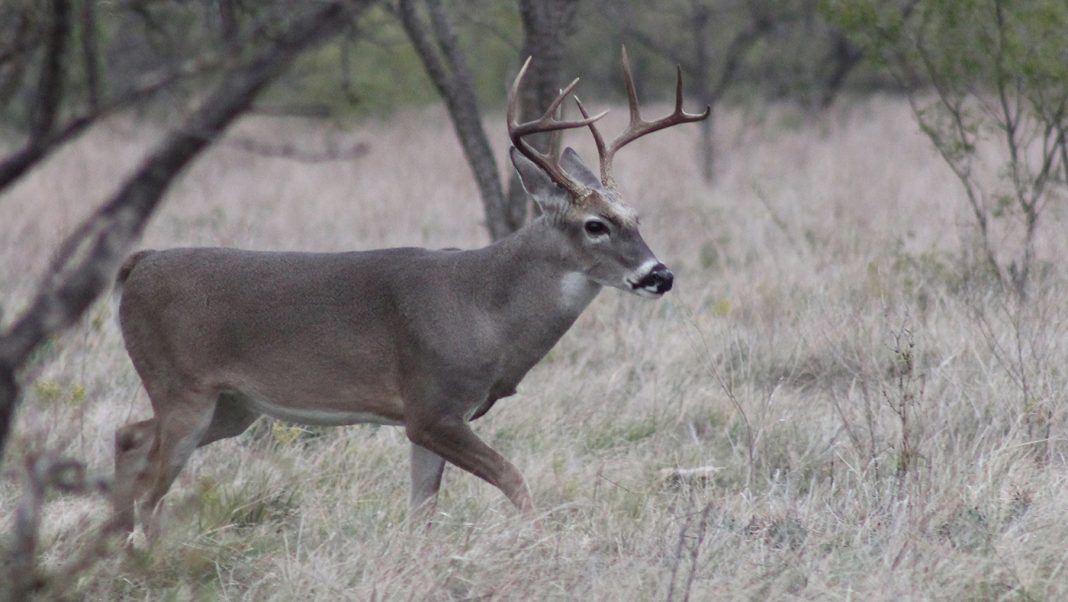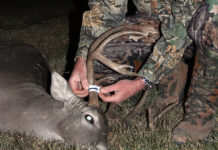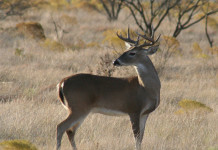Chronic wasting disease is not prevalent in Texas but recent positive test results from deer breeding facilities in separate regions of the state are certainly troubling news for the Texas Parks and Wildlife Department and the Texas Animal Health Commission.
The agencies reported this week that CWD was discovered in breeding facilities in Hunt and Uvalde counties. This marks the first positive detection of the disease in Hunt County, which sits east of the Dallas-Fort Worth Metroplex. Uvalde County is more than 400 miles southwest of there, west of the San Antonio metro area.
According to TPWD: “The tissue samples were submitted by the deer breeding facilities as part of required CWD surveillance programs. The samples indicated the presence of CWD during testing at the Texas A&M Veterinary Medical Diagnostic Laboratory in College Station on March 23 for the Uvalde County facility. Samples indicated the presence of CWD during testing at the TVMDL on March 24 for the Hunt County facility. The National Veterinary Services Laboratory in Ames, Iowa, has since confirmed CWD in those tissue samples, but the samples reported for Hunt County are undergoing DNA testing to confirm animal identification and origin.”
TPWD also noted that “officials have taken immediate action to secure all deer at the Uvalde County and Hunt County deer breeding facilities and plan to conduct additional investigations for CWD. In addition, other breeding facilities that received deer from these facilities or shipped deer to these facilities during the last five years are under movement restrictions and cannot move or release deer at this time.”
“Recent CWD discoveries in new locations across the state are deeply concerning and underscore the criticality of redoubling efforts to help arrest the spread of this disease,” said Carter Smith, Executive Director of TPWD, in a prepared statement. “While it is important to realize that CWD is still not widespread in Texas, complacency is not an option. The only way to ensure we are effective in combating the further spread of CWD is with the active help of hunters, wildlife managers, deer breeders, and landowners. Clearly, it is imperative that we work together to protect our native deer populations to ensure the health and vitality of one of our state’s greatest natural resources.”
TPWD and TAHC officials said that both breeding facilities had active CWD surveillance programs with no positives detected until the most recent samples.
John True, Texas Deer Association President, confirmed the news, noting that the Uvalde County outbreak included multiple cases.
“All five suspect positives from Uvalde County have now been confirmed,” True wrote in an email. “The suspect positive from Hunt County has also been confirmed, but they’re waiting on DNA analysis to confirm the identity and origin of that particular sample before reaching out to affected farms to discuss individual herd plans. This could take 2-3 weeks to confirm.”
CWD is a fatal transmissible neurological disease in the family of infectious diseases that include bovine spongiform encephalopathy, commonly known as “mad cow disease,” scrapie in sheep, feline spongiform encephalopathy in cats in Europe, and Creutzfeldt-Jakob disease and a new variant in humans. CWD is believed to be caused by a misfolded protein that replicates and infects normal proteins, according to researchers. CWD is named for its symptoms, including appetite loss, weight loss, listlessness, excessive drooling, blank stares, decreased awareness and behavioral changes. The diagnosis of the disease can’t be made by symptoms since other toxic and neurological afflictions can cause an animal to exhibit similar symptoms, according to researchers.
CWD originally was discovered in captive Colorado animals 35 years ago. However, during the past five years the disease has been detected in free-ranging deer and elk in several surrounding states and Canada. In 2002, a year after Texas closed its borders to importation of deer due to disease risks, CWD was reported in free-ranging deer in South Dakota, Wisconsin, New Mexico, Illinois and Utah.
In Texas, the disease was first discovered in 2012 in free-ranging mule deer along a remote area near the Texas-New Mexico border and has since been detected in 220 captive or free-ranging cervids, including white-tailed deer, mule deer, red deer and elk in 11 Texas counties, according to TPWD.
CWD, which has no known immunity or treatment, occurs via natural transmission in deer, elk and moose. However, research indicates that infection of livestock through natural pathways is unlikely. It should be noted that the disease has not shown the ability to jump the species barrier to humans, according to researchers.
CWD has been shown to affect the brain, spinal cord and other lymph areas of infected animals, but proper field dressing typically removes any of these sites and hunters are advised to also bone out their meat. If you take animals to be processed commercially, ask that the meat be handled separately from that of others, too. If you suspect an animal you harvest has some type of disease, wildlife officials urge you to keep the carcass refrigerated or on ice and contact biologists, and certainly don’t attempt to eat any of the meat.
One troubling aspect of CWD is proof that it can spread, remain dormant for years and still affect natural resources, according to researchers. Case in point: a shipment of elk from an infected herd in Canada to South Korea in 1997 went undetected for nearly 10 years. Despite tracing back the imported animals, which were euthanized for testing in 2005, CWD persists in that country, TPWD officials said. The disease previously had been found only in Canada and the U.S.
Eradication of the disease increasingly is expected to become less attainable if it spreads through more populations, according to researchers. That makes a surveillance plan critical to the earliest detection followed with an adequate response plan.
TPWD previously regulated the importation of white-tailed deer and mule deer through its scientific breeder permit program. TAHC entry requirements were incorporated into the permit program and deer imported from other states must have originated from herds enrolled in an official CWD monitoring program for at least three years. In states where the disease was detected, the required monitoring period was extended to five years. Those frameworks still exist for the importation of other cervids including elk, red deer and sika deer.
“The incubation period of CWD can span years creating disease management challenges,” said Dr. Andy Schwartz, TAHC State Veterinarian, in a prepared statement. “Response staff are diligently working to address each herd affected by these new detections to manage further spread.”
More information: Texas Parks and Wildlife Department CWD Website
More information: Texas Animal Health Commission CWD Website
Chronic wasting disease in Texas brings increased testing, precautions
200 deer at South Texas ranch euthanized, tested for chronic wasting disease





















